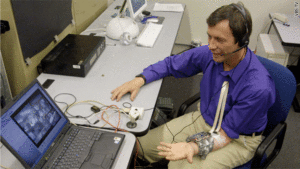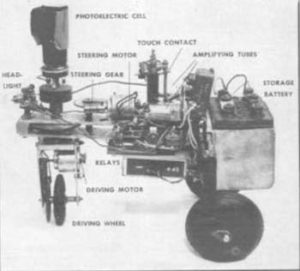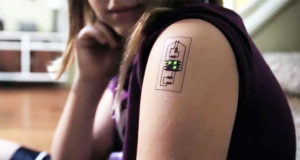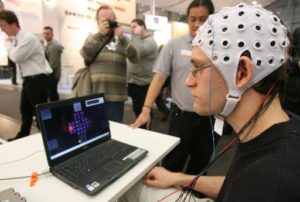
"The important thing is not to stay alive but to stay human.
George Orwell
The joint evolution of the human factor and technology has been called technogenesis by several authors. Not many years ago, science fiction predicted that, in the future, the human being would be a collection of biological material, cables and hardware. That future is already here. It is more and more common to use technological means for the treatment of multiple diseases or syndromes. Articulated and movable mechanical arms are available, and even brain implants with which vision or motor skills are recovered. This technology takes the human being far beyond his biological capabilities, entering the field of what has been called post-humanism.

In 1998, the British scientist Kevin Warwick experimented with the installation of chips on humans (his prototype can be seen at the Science Museum in London). Warwick's best known research is the so-called ProjectCyborg (origin of his nickname "Captain Cyborg"), a series of trials among which he implanted a chip in his arm to become a cyborg. Through him, his nervous system was connected to the Internet at Columbia University and, from there, he was able to control a robot arm at the University of Reading. Later, he attached ultrasonic sensors to a baseball cap in order to experiment with new forms of perception.
There are already people who have been recognized by the authorities as cyborgs. For example, Neil Harbisson, who suffered from acromatopsia, could not perceive colors, his world was a gray scale. Today, Harbisson uses "a sensory enhancement device in the form of an antenna mounted on his head, attached to a chip located in the back of his skull"[1]. . This system converts colors into sounds, so that he can "hear" the electromagnetic energy of each color. Officially recognized as the first cyborg, it considers the system it is attached to as an integral part of him.
These so-called enhancement technologies replace parts of the human being, and for that they have to simulate being biological organisms when, in fact, they are computer technologies. Brain-computer interfaces allow people with neurological disabilities to regain functions through technology that they had biologically lost.
This very rapid evolution of technologies not only allows the creation of technology that emulates being biological and can be assembled with biological organisms. It also obtains information from the human being's own organs. Scientists from Yale University have managed, through brain scans, to recreate the images of the faces that the participants were looking at. This assumes that the sensory information received by the eyes is passed on to the brain, and that this information can be extracted with a scanner and recreated.
Neurorobotics
Within the spectrum of robotics, the mind can be assembled into technological mechanisms. Since the perceptions and representations made by the mind are simulations of the information of the real environment, neurocognition has a continuous and direct relationship with the information from the outside. In robots, this relationship between external information and neurocognition is artificial in both senses, since robotic neurocognition is an artificial creation and the external information it processes is previously coded.

Although the creation of automata systems can be traced back to ancient Greece, with the mechanical inventions of Heron of Alexandria, the American William Grey Walter is considered the father of robotics, at least of modern ones. This neurologist, who specializes in robotics and neurophysics, discovered a way to detect brain tumors using the alpha waves of the electroencephalogram and realized the possibility of imitating neuronal behavior in an artificial system. His robot Machina Speculatrix was the starting point for the next generations of robots.
Robotics has undergone substantial changes in recent years, coming to create androids (robots in human form) capable of developing complex activities and learning from experience. This degree of development has made it possible to reduce costs to the point that, for almost a decade, it has been possible to build a robot at home, controlled by mental signals collected by an affordable electroencephalographic band, which reproduces sounds and flashes lights [2] .
Robots have a well-studied relationship with the neuronal and cognitive system. It is not in vain that neurorobotics has been investigating for years the ways to develop artificial networks, computer models and hybrid systems of artificial life. Inspired by biological models, neurorobotics tries to reproduce the neuronal knowledge of human beings, and mainly of neurocognition, in mechanical or virtual ways. In the construction of robots, all the specialties of neurosciences have been applied. For example, the knowledge about the visual neural system has served to improve their visual capacity. And studies about neuromodulators, such as dopamine, have made it easier for them to make decisions. With these two applications, robots can associate visual information with a code that helps them choose the next behavior [3] .
Even so, the cognitive process and the human nervous system, both tremendously complex, are still in the study phase, making it impossible to reproduce them in their entirety. Neurobotics provides great help in that aspect because it allows the artificial recreation of theoretical models of the functioning of the mind, and that later they can be verified to redefine the theories [4] .

Transhuman skin
The skin is the organic tissue that receives most of the sensations of the environment (temperature, pressure, humidity, pain) and transmits them to the brain. Getting to transmit tactile sensation is a milestone in the technological revolution of the mind, and like other technologies in this area, it will not take long to be applied even to people with their natural faculties.
The objective is to achieve that through the skin we can practice other senses, such as, for example, that the brain perceives smells from the skin and not from the olfactory system.
Drug and Drug-Enhanced Transhumanism
The empowerment of mental faculties through the use of drugs and medication is widely studied from different perspectives. Increasing attention, memory, creative capacity, even problem-solving ability has been and is a relatively common practice for many people with very different needs, eager for enlightening, playful or soul-releasing experiences.
Throughout history, and especially in recent centuries, many artists and intellectuals have been tempted to take various drugs to enhance their creativity. And many students have used amphetamines or similar to improve their performance on exams.
The consumption of psychochemical or psychoactive drugs is an inexpensive and accessible way to hack biology while the effect lasts, although prolonged use leaves obvious and noticeable consequences on physical and mental health. It is common for it to degenerate into an addiction, since the feeling of personal improvement provided by these substances calls for greater consumption and increasingly high doses, ending up generating an absolute dependence from which few users escape.

As early as the 1950s, millions of American housewives were addicted to "Mother's Little Helpers," as the Rolling Stones denounced in their album Aftermath. These helpers were household amphetamines that gave housewives energy to get through their chores. In this same line, the world's quintessential soft drink, Coca Cola, has its origin in an energy drink made from cocaine (in the French coca wine). Today we see how it is most common that the shelves of supermarkets are full of energy drinks to which they have added high doses of caffeine, ginseng, theine, guarana or any other active ingredient that enhances the physical and mental capabilities of the consumer.
All these promises of improvement that are freely sold as harmless, have more negative effects than proven qualities. Although they are sold with the message of increasing physical endurance, allowing, for example, endless hours of dancing in the disco or keeping attention on driving for longer, they act on the brain chemistry, making you not perceive a tiredness that is actually happening and that, once the effects are over, the body will notice it increased. It just fools the mind about what is happening to the body.
The continued abuse of these harmful substances, as well as other illegal psychostimulants, to increase mental abilities is known as "brain doping," and it is widely demonstrated and documented that this practice often causes more brain and heart damage than it provides benefits.
These two negative consequences are what research into new drugs is trying to solve. At this rate, it will not be long before a pill is found that will improve mental skills for weeks and whose prolonged use is harmless.
Improvement through cerebral electro-stimulation
Technology is playing a decisive role both in medicine and in disciplines focused on going beyond biology, to the detriment of drugs and artificial chemicals. Most of the current research is focused on getting the body to regenerate and improve itself, through neuronal or nerve stimulation that causes the body to create a certain type of neurotransmitters or chemicals.
As studies show, the advantages of the direct application of electrical impulses are that their immediate results lack the adverse effects of psychochemical drugs, and the increase in mental capacity is greater.
The digital bioelectric man is already a palpable reality, and it will not take long to assume as a daily reality the different procedures to improve the results of the work tasks in the civil area.

It has been demonstrated that with brain electrostimulation the quality of tasks can be doubled up to twenty-four hours after application. This makes it necessary to legislate on the quantity and load of electrostimulation applicable in the work environment. Otherwise, surely someone has the brilliant idea of electro-stimulating workers almost constantly, to increase their performance and their own profitability. In fact, it has been frequently applied with drone pilots in the course of operations, who have to spend long hours controlling the flight of multiple devices.
Having shown that electrostimulation can increase all aspects of mental and psychomotor abilities, we cannot ignore its effects on the psyche of the person when these purposes are pursued. By means of electrical stimulation of the brain, behaviors and decisions rooted in the deepest part of the human psyche can be altered and controlled. For example, inducing electrical discharges in the prefrontal cortex can increase or decrease the tendency to lie. Neuroscientific studies have associated the dorsolateral prefrontal cortex with behaviors that attempt to deceive, concluding that stimulation of the right hemisphere decreases the tendency to deceive, while stimulating the left hemisphere increases the tendency to deceive.
Neither torture nor the chemicals used unblock the mind and have never been able to discern whether what a detainee told was true or false. Now a way may have been found to prevent a lie from coming out of a person's depth or, on the contrary, to force him or her to lie.
Mind-body connection
The evolution of the body-internet connection continues unstoppable. At present, the mechanism by which these pre-programmed devices can control the chemistry of the brain, blood or any other biological organ, and even dose drugs to its carrier, is being studied.
It is a very near future, these devices, intimately linked to our bodies, will be part of the Internet of Things, that already so close world in which most of the objects that surround us - appliances, vehicles, work tools, home automation... - will be controlled from and by the Net. In addition, these devices will control the functioning of bionic prostheses.

The mass production of this state-of-the-art technology is already being studied for widespread application to the populations of the poorest countries, justifying it as humanitarian aid. Without a doubt, this initiative will help control the health of millions of people living in areas where the state lacks the means to store and control medical records, but its capacities are still limited [5] .
Social repercussions of mental transhumanism
The ethical debate about providing drugs or inserting prostheses to a healthy person shows the concern for the undoubted dangers associated - cognitive independence or the loss of real and perceived new identity [6] -, which has all the logic thinking about its social repercussions
Altering the nature of the human being through genetic manipulation or high technology can create an insurmountable division between those who can access that knowledge and those who cannot.
However, we cannot be naive because this division has always existed. The possessors of the most modern and advanced weapons had an advantage over obsolete armies. In civil society, those with more resources had access to technology that made their lives easier. And the rich and powerful have always had access to medical advances unattainable for the common man, which continues to happen today even in the most developed countries, since there are treatments that are only carried out in a handful of private clinics, with costs that can only be assumed by a few.
But the truth is that now access to biotechnology is going to mean a quantitative leap in the biological capacities of the human being, with all the potential to modify the social order. For the first time, technological evolution will not be external, but integrated; it will not be a prescriptive treatment, but a free and personal decision.
 Cognitive information processing functions, such as perception, attention, memory, learning, planning, concept formation, reasoning and problem solving, will be biotechnologized in the near future. By the time this happens, unaltered biological minds will be at a clear disadvantage, and may be relegated almost to a category of subpersons, the new technological slaves, who will only be able to perform the less complex tasks. Except for a few gifted people who, at least for a time, still have mental faculties superior to those of people with implants. What will happen is that soon we will see mental implants as the current dental implants, which, if they had been told about them to our close ancestors, they would never have believed it, or they would think it was a matter of witchcraft, that it could not be good.
Cognitive information processing functions, such as perception, attention, memory, learning, planning, concept formation, reasoning and problem solving, will be biotechnologized in the near future. By the time this happens, unaltered biological minds will be at a clear disadvantage, and may be relegated almost to a category of subpersons, the new technological slaves, who will only be able to perform the less complex tasks. Except for a few gifted people who, at least for a time, still have mental faculties superior to those of people with implants. What will happen is that soon we will see mental implants as the current dental implants, which, if they had been told about them to our close ancestors, they would never have believed it, or they would think it was a matter of witchcraft, that it could not be good.
When that day comes, unaltered minds will be forced to compete with minds that have been empowered by the consumption of cheaper augmentatives, such as second generation psychopharmaceuticals, or the practice of mind training techniques, such as meditation or yoga. In fact, this competition between artificially modified minds and those that are not is already taking place in our society, albeit in silence.
Many people manage to pass tests and exams thanks to the illicit use of this kind of drugs, which leaves those who present themselves without artificial help at a clear disadvantage, some because of personal ethical principles, others because they do not know them and some because their economy does not allow them to acquire them.
The use of these types of substances is justified by the cognitive freedom of each person, but this concept does not take into account that their consumption is simply unfair competition.
This dichotomy confronts two philosophical groups: the transhumanists and the bio-conservatives. The defenders of transhumanism argue that limiting the possibility of improving human biological capabilities is a neoliberal imposition, in line with the argument of French philosopher and psychologist Michel Foucault about biopower, who believed from another angle that these technologies could be used to control the population. But this progressive vision implies the existence of a liberal competition for access to the most advanced methods of artificially improving biological capabilities.

The paladin of transhumanism accept that access to technology will bring greater social inequalities, and assume that it will be a minority elite who will complete the new post-human. As a curiosity, the greatest defender of transhumanism was the British Julian Huxley [7] , when his brother Aldous Huxley already recognized, in his well-known book "Brave New World", this social difference motivated by the disparate access to knowledge and technology.
Meanwhile, on the bio-conservative side, an amalgam of religious groups and social activists, demand, on the one hand, that the biology granted at birth shall not be altered and, on the other, that if it is altered, it shall be for the benefit of society as a whole, and not limited to a few, an elite [8] . In this sense, the claims of the bio-conservatives are closer to the psycho-civilized vision of society proposed by the Spanish scientist José Delgado.
Doubts about transhumanism
Transhumanism and post-humanism bring to the table both interesting and controversial debates about the meaning of the human being and his social nature, among which, as Bernard Shaw suggested in "Man and Superman", no superhuman transformed by biotechnology will want to be treated as a normal being. The ethical issues raised by genetic engineering are forcing legislation on its use, and regulations will have to be more specific to accommodate advances.
Progress has not only failed to end classic social inequalities, but has brought new ones, as well as a strict control of all aspects of our lives, as never before; from taking a walk to spending a small amount of money, everything is subject to the watchful and omnipresent eye of "progress".
Humanist individualism, considered by many as the culmination of humanity's progress, has ended up devouring the person, whom it theoretically extols and enthrones, almost placing him in a divine category, but leaving him, in reality, in the category of the modern digital slave, Subjected not only by the chains of his own physical nature and his emotions, passions, feelings and weaknesses, but also by those of some elites who have digitally lobomized him until he is convinced that he is the possessor of a freedom as fictitious as it is fragile, always subject to the dictates and ups and downs of power.
To overcome these circumstances, some rely on technology that elevates the person to the status of post-human and transhuman. But it is not clear that this is not another trap into which those of us who have not been mere puppets for a long time fall, only that we are no longer made of rags, string and wood, but are equipped with the most advanced technology. Among other things because the design of that human being of the immediate future is going to result from today's beliefs.
Pedro Baños is author of "El Dominio Mental", published by Ariel Editorial
[1] Barfield (2015)
[2] Karvinen and Karvinen (2011)
[3] Giannopulu (2019)
[4] Artemiadis (2016), p. 208
[5] Sandvik (2020)
[6] Hildt (2013)
[7] Biologist and first director of UNESCO.
[8] Reiner (2013)
Bibliography
Artemiadis, Panagiotis. Neuro-Robotics: From Brain Machine Interfaces to Rehabilitation Robotics. Springer. 2016.
Barfield, Woodrow. Cyber-humans: Our future with machines. Copernicus. 2015.
Giannopulu, Irini. Neuroscience, Robotics and Virtual Reality: Internalised Vs Externalised Mind/Brain. Springer. 2019.
Hildt, Elisabeth. "Cognitive enhancement-A critical look at the recent debate." Cognitive enhancement. Springer:1-14. 2013.
Karvinen, Tero, and Karvinen, Kimmo Make a Mind-Controlled Arduino Robot: Use Your Brain as a Remote. Maker Media. 2011.
Reiner, Peter B. "The biopolitics of cognitive enhancement." Cognitive Enhancement. Springer:189-200. 2013.
Sandvik, Kristin Bergtora. "Humanitarian Wearables: Digital Bodies, Experimentation and Ethics." Ethics of Medical Innovation, Experimentation, and Enhancement in Military and Humanitarian Contexts. Springer: 87-104. 2020.
 Copyright secured by Digiprove © 2020 Quixote Globe
Copyright secured by Digiprove © 2020 Quixote Globe